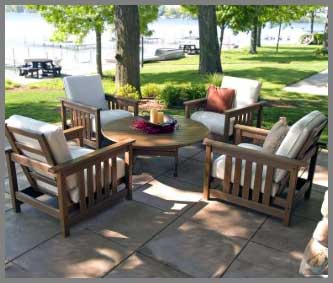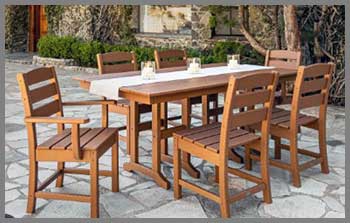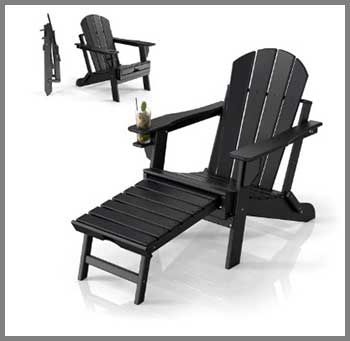
When I set out to revamp my outdoor space, I faced a choice between Polywood and HDPE furniture.
Both materials promise durability and eco-friendliness, but which one truly delivers for my patio? In this article, I’ll explore Polywood and HDPE, breaking down their pros, cons, and maintenance needs while sharing my hands-on experience.
You’ll find a clear comparison table, practical insights, and answers to common questions to help you decide what’s best for your outdoor oasis.
My goal is to guide you through this decision with clarity and confidence.
Comparison Table: Polywood Vs Hdpe
| Feature | Polywood | HDPE |
|---|---|---|
| Material Composition | Recycled high-density polyethylene (HDPE) with UV inhibitors and additives | High-density polyethylene, often recycled, sometimes mixed with additives |
| Durability | Extremely durable, resists weather, fading, and cracking | Highly durable, withstands harsh weather, non-porous |
| Maintenance | Low, soap and water cleaning | Low, simple soap and water cleaning |
| Eco-Friendliness | Made from 99% recycled plastics, fully recyclable | Often made from recycled plastics, recyclable |
| Weight | Heavier, denser, stable in wind | Varies, can be lighter or heavier depending on additives |
| Aesthetic | Mimics wood, wide color and style options | Wood-like appearance, versatile designs |
| Cost | Higher initial cost, long-term value | Varies, often slightly cheaper |
| Warranty | Typically 20-year residential warranty | Varies by brand, often 5-20 years |
My Experience With Polywood
I’ve had a Polywood Adirondack chair and dining set on my deck for two years now, and I can say it’s been a game-changer for my outdoor living. The first thing I noticed was the weight—these pieces are hefty, which I love because they don’t budge in strong winds, unlike my old plastic chairs that went flying during storms.
The classic wood-like finish on my navy-blue chairs gives my patio a polished, timeless vibe, almost like real wood but without the splinters or constant upkeep. I chose Polywood because of its eco-friendly reputation, knowing it’s crafted from recycled milk jugs and detergent bottles. That felt like a win for both my backyard and the planet.
Sitting in the Adirondack chair is comfortable, though I’ll admit the rigid HDPE material doesn’t mold to your body like a cushioned seat might. On hot summer days, I’ve noticed the darker color retains some heat, so I toss a towel over it before sitting. Cleaning is a breeze—I just hose it down with soapy water, and it looks brand new.
Over time, I’ve added a side table and noticed Polywood’s consistent color options made it easy to match pieces years later. The 20-year warranty gives me peace of mind, but honestly, these pieces still look untouched by the Florida sun and rain. My only gripe? The upfront cost was steep, but I see it as an investment that’s already paying off.
Pros Of Polywood

- Eco-Friendly Credentials: Polywood is made from 99% recycled plastics, like milk jugs and shampoo bottles, reducing landfill waste. Its manufacturing process is vertically integrated, recycling 99% of HDPE scraps, making it a standout for sustainability.
- Exceptional Durability: Built to last up to 50 years, Polywood resists cracking, splintering, and fading, even in harsh weather like rain, snow, or intense UV rays. My set has endured two years of coastal storms without a scratch.
- Low Maintenance: Cleaning is as simple as soap and water with a soft brush. No need for painting, staining, or sealing, which saves me hours compared to maintaining wooden furniture.
- Weather Resistance: Polywood is engineered to withstand extreme conditions—sun, saltwater, or snow—without warping or mold growth. It’s perfect for year-round outdoor use in any climate.
- Aesthetic Versatility: With UV-inhibited pigments, Polywood offers vibrant, fade-resistant colors and wood-like textures. I love the variety of styles, from classic Adirondack chairs to modern dining sets, fitting any outdoor vibe.
- Long Warranty: Most Polywood pieces come with a 20-year residential warranty, offering confidence in its longevity. This was a deciding factor for me when choosing a brand.
- Scratch Concealment: The color runs through the material, so scratches are less noticeable. I’ve bumped my dining table a few times, and you can’t tell.
Also read: My Thoughts on Floor & Decor Vs. Home Depot
Cons Of Polywood
- High Initial Cost: Polywood furniture is pricier than standard plastic or even some wood options. My dining set was a significant investment, though I justify it with its long lifespan.
- Heavy Weight: The dense HDPE makes Polywood furniture heavier than alternatives, which is great for stability but a hassle if you like rearranging your patio often. Moving my table solo is a workout.
- Heat Retention: Darker-colored Polywood pieces can get hot in direct sunlight. I learned this the hard way on a 90-degree day when my chair felt like a skillet.
- Rigidity: The HDPE material doesn’t flex or conform to your body, which can feel less comfortable for long lounging sessions without cushions. My Adirondack chair is sturdy but not cozy.
- Limited Brand Options: Polywood is a specific brand, so you’re locked into their designs and pricing. I sometimes wished for more budget-friendly alternatives with the same material quality.
- Assembly Required: Some pieces, like my dining set, required assembly with bolts and screws. While straightforward, it took me an afternoon, and I’d recommend a second pair of hands.
- Not Fully Flexible Designs: While versatile, Polywood’s styles lean toward traditional or coastal looks, which might not suit ultra-modern or minimalist preferences.
Maintenance Tips For Polywood
- Regular Cleaning: Use mild soap and water with a soft-bristle brush to clean dirt or stains. I do this monthly, and it keeps my furniture looking pristine without much effort.
- Avoid Harsh Chemicals: Stick to gentle cleaners to preserve the UV-resistant coating. I once used a strong detergent, and it dulled the finish slightly, so I learned my lesson.
- Tough Stain Removal: For stubborn stains like food spills, mix one part bleach with two parts water and scrub gently. This worked wonders when my kid spilled ketchup on the table.
- Winter Storage: While Polywood can stay outside year-round, I cover mine during heavy snow to prevent ice buildup. A breathable cover works best to avoid trapped moisture.
- Check Fasteners: Periodically tighten bolts and screws, as they can loosen with weather changes. I check mine every six months to ensure stability.
- Protect from Heat: In scorching climates, consider shade or covers for darker pieces to reduce heat retention. I use a patio umbrella to keep my chairs cooler.
- Polish for Shine: For extra luster, I occasionally use a plastic polish designed for HDPE. It’s not necessary but gives my set a showroom glow.
My Experience With Hdpe
I also own a couple of HDPE chairs from a lesser-known brand, picked up at a local retailer to complement my Polywood set. These chairs, made from recycled HDPE like Polywood, are slightly lighter, which makes rearranging my deck easier.
The finish is smoother, almost waxy, and while it mimics wood, it feels a bit more plastic-like than Polywood’s textured grain. They’ve held up well through a year of rain and sun, with no fading or cracking, but I noticed the color (a light gray) shows dirt more than my darker Polywood pieces.
The HDPE chairs were cheaper, which was a draw, but they don’t have the same robust warranty—only five years compared to Polywood’s 20. They’re comfortable for quick sits but, like Polywood, lack the cushioning feel of fabric or wood.
Cleaning is just as easy, and I appreciate the eco-friendly aspect, knowing they’re made from recycled plastics. However, the brand’s limited color options meant I couldn’t perfectly match my existing setup. Overall, HDPE is a solid choice, but I lean toward Polywood for its refined look and longer-term reliability.
Pros Of Hdpe

- Durability: HDPE is tough, resisting weather, UV rays, and moisture without cracking or splintering. My chairs have endured a year of coastal humidity with zero issues.
- Eco-Friendly: Often made from recycled plastics like milk jugs, HDPE reduces landfill waste. Knowing my furniture helps the environment feels good.
- Low Maintenance: A quick wash with soap and water keeps HDPE looking new. I’ve never needed to paint or seal, saving me time and money.
- Weather Resistance: HDPE handles rain, sun, and snow effortlessly, making it ideal for year-round outdoor use. My chairs stay outside without worry.
- Cost-Effective: HDPE furniture is often slightly cheaper than Polywood, offering similar benefits at a lower price point. My chairs were a budget-friendly find.
- Lightweight Options: Some HDPE pieces are less dense, making them easier to move. Rearranging my deck is less of a chore with these chairs.
- Versatile Applications: HDPE is used in various furniture types, from Adirondack chairs to wicker sets, fitting diverse outdoor styles.
Cons Of Hdpe
- Variable Quality: Not all HDPE brands match Polywood’s standards. My chairs feel slightly less premium, with a more plastic-like texture.
- Shorter Warranties: Many HDPE brands offer 5-10 year warranties, less reassuring than Polywood’s 20 years. I worry about long-term durability.
- Color Limitations: Some HDPE brands have fewer color options, making it hard to match existing decor. My gray chairs clash slightly with my navy set.
- Heat Retention: Like Polywood, darker HDPE pieces can get hot in the sun. I avoid sitting on mine during peak heat without a towel.
- Less Refined Aesthetic: HDPE can look more plastic-like, lacking Polywood’s wood-like texture. My chairs don’t have the same upscale vibe.
- Potential Flexing: Some HDPE furniture has slight flex, especially in seats, which can feel less sturdy. My chairs creak a bit under heavier guests.
- Brand Inconsistency: HDPE quality varies by manufacturer, so research is key. I took a risk on a lesser-known brand and got mixed results.
Maintenance Tips For Hdpe
- Routine Cleaning: Wash with mild soap and water using a soft cloth or brush. I do this every few weeks to keep dirt at bay.
- Avoid Abrasive Tools: Use non-scratch brushes to prevent surface damage. I scratched my chair slightly with a rough sponge early on.
- Stain Removal: For tough stains, a diluted bleach solution (1:2 with water) works well. It removed a wine stain from my chair easily.
- Cover in Extreme Weather: While HDPE is durable, I cover mine during prolonged storms to minimize wear. A tarp works fine.
- Inspect Hardware: Check screws and bolts regularly, as they can loosen. I tighten mine quarterly to keep the chairs stable.
- UV Protection: If not UV-treated, some HDPE may fade. I apply a UV-protectant spray yearly to maintain color vibrancy.
- Store Cushions: If your HDPE furniture has cushions, store them indoors during winter to prevent mold. I learned this after a soggy cushion incident.
Read more: My Thoughts on Houzz Vs. Thumbtack
Comparison With Other Brands
- Trex: Trex uses a composite blend of HDPE and wood fibers, offering a more natural wood look but with potential for water absorption and mold. Polywood’s pure HDPE feels more durable to me.
- Serwall: Serwall combines HDPE and HIPS, providing a budget-friendly alternative. However, its recycling process isn’t as robust as Polywood’s, and I found the designs less refined.
- Highwood: Highwood’s HDPE furniture is similar to Polywood but often cheaper, with shorter warranties. My friend’s Highwood set faded slightly after two years, unlike my Polywood.
- Berlin Gardens: This brand uses HDPE with a focus on luxury designs. Their pieces are stunning but pricier than Polywood, which suited my budget better.
- Seaside Casual: Their composite furniture mimics wood well but can be heavier than Polywood. I prefer Polywood’s simpler maintenance over Seaside’s upkeep needs.
- Polytrend: A newer HDPE brand, Polytrend offers lower prices but lacks Polywood’s proven track record. I avoided it due to limited long-term reviews.
- Phat Tommy: Phat Tommy’s HDPE furniture is recyclable and durable but less polished than Polywood. Their Adirondack chairs felt flimsier in a store test.
Frequently Asked Questions (Faq)
Polywood is a brand that uses HDPE (high-density polyethylene) as its primary material, but not all HDPE furniture is Polywood. Polywood’s proprietary process includes UV inhibitors and additives for enhanced durability and aesthetics.
Polywood’s main downsides are its high initial cost, heavy weight, and heat retention in darker colors. It can also feel rigid and may require assembly, which can be time-consuming.
Yes, HDPE is excellent for outdoor furniture due to its durability, weather resistance, and low maintenance. It’s eco-friendly and withstands sun, rain, and snow without fading or cracking.
HDPE Adirondack chairs are great for their durability, low upkeep, and eco-friendly nature. They resist weather and pests but may feel rigid and lack the warmth of wood.
Conclusion: For Polywood And Hdpe
Choosing between Polywood and HDPE comes down to your priorities. If you value a premium, eco-friendly brand with a long warranty and refined aesthetics, Polywood is your go-to—my set proves its worth every day.
If budget is a concern and you’re okay with variable quality, generic HDPE offers similar benefits at a lower cost. Both materials are durable, low-maintenance, and sustainable, making them smart investments for your outdoor space. Weigh your needs, consider my experiences, and you’ll find the perfect fit for your patio dreams.
